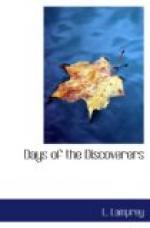Their provisions were those of any ship sent on a voyage into unknown lands in those days—dried and salted meat and fish, flour and meal to be made into cakes or porridge, dried pease, dried beans. For a time the Indians visited them, in the bitterest weather, but in December even this source of a game supply was cut off, for they came no more. The dreaded scurvy broke out, and before long there were hardly a dozen of the whole company able to care for the sick. Besides the general misery they were tormented by the fear that if the savages knew how feeble they were the camp might be attacked and destroyed. Cartier told those who had the strength, to beat with sticks on the sides of their bunks, so that prowling Indians might believe that the white men were busy at work.
But the wild folk were both shrewder and more friendly than the French believed. Their medicine-men told Cartier one day that they cured scurvy by means of a drink made from the leaves and bark of an evergreen. Squaws presently came with a birch-bark kettle of this brew and it proved to have such virtues that the sick were cured of scurvy, and in some cases of other diseases which they had had for years. Cartier afterward wrote in his report that they boiled and drank within a week all the foliage of a tree, which the Indians called aneda or tree of life, as large as a full-grown oak.[3] Many had died before the remedy was learned, and when the weather allowed the fleet to sail for home, there were only men enough for two of the ships. The Indians had told of other lands where gold and rubies were found, of a nation somewhere in the interior, white like the French, of people with but one leg apiece. But as it was, the country was a great country, and well worth the attention of the King of France. Leaving the cross and the fleur-de-lis to mark the place of their discovery, the expedition sailed for France, and on July 16, 1536, anchored once more in the port of Saint Malo.
“And there is no Norumbega really?” asked little Margot rather dolefully, when the story of the adventure had been told. “And your hair is all gray, here, on the side.”
“None the less I have gifts for thee, little queen, and such as no Queen of France hath in her treasury.” Maclou’s smile, though a trifle grave, had a singular charm as he opened his wallet. Margot nestled closer, her eyes bright with excitement.
The first gift was a little pair of shoes of deer-skin dyed green and embroidered with pearly white beads on a ground of black and red French brocade. They had no heels and no heavy leather soles, and were lined with soft white fur; and they fitted the little maid’s foot exactly.
The second gift was a girdle of the same beads, purple and white, in a pattern of queer stiff sprays. “That,” said Alain Maclou, “is the Tree of Life that cured us all of the sickness.”
The third was a cluster of long slender crystals set in a fragment of rock the color of a blush rose.[4]




